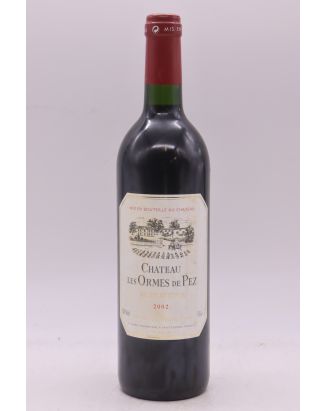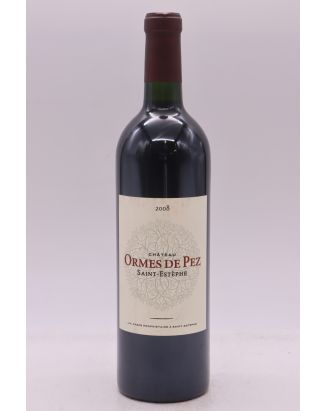










The origins of Château Ormes de Pez date back to the 18th century, when it was still known as the Domaine de Pez. This name means "peace" in the local dialect, and the first mention of the estate already reflects the serenity and grandeur of the place. After the French Revolution, the estate adopted its current name, in tribute to the majestic elm trees that once populated the landscape. Unfortunately, these iconic trees have disappeared, but they remain symbolic and are still featured on the estate's bottle labels.
Over the centuries, the estate has changed hands several times, going through periods of evolution and rehabilitation. It was in 1940 that Jean-Charles Cazes, a member of the famous Cazes wine family, acquired the estate. The Cazes family, already owners of Château Lynch-Bages in Pauillac, also invested in the modernisation and development of Château Ormes de Pez. In the 1980s, Jean-Michel Cazes, the grandson of Jean-Charles, renovated the historic buildings and introduced technical innovations, while preserving the soul and charm of the property. Today, it is Jean-Charles Cazes, namesake of his great-grandfather, who passionately manages this beautiful estate and strives to pass on the family heritage.
Located in the north of the Saint-Estèphe appellation, Château Ormes de Pez benefits from an exceptional terroir, influenced by the proximity of the Gironde estuary and the Atlantic Ocean. This temperate oceanic climate contributes to the optimal maturity of the grapes while preserving their freshness. Only 60 km from Bordeaux, the estate enjoys ideal natural conditions for viticulture, combining mild climate and soils conducive to the deep rooting of the vines.
The vineyard covers 40 hectares and is divided into two distinct soil types. The gravelly plots, rich in quartz and rolled pebbles, mainly accommodate the cabernet sauvignons, grape varieties that thrive particularly well on these draining soils. The other plots, which are clay-sandy, are more suitable for the merlots, which bring roundness and richness to the blends. The grape variety composition of Château Ormes de Pez is therefore 54% cabernet sauvignon, 37% merlot, 7% cabernet franc, and 2% petit verdot, a variety in small proportion that adds a touch of complexity to the wines.
As part of a reasoned agriculture approach, the estate's technical team, under the direction of Rafaël Destruhaut-Balladu, adopts environmentally friendly practices. Phytosanitary control is optimised to reduce the impact on biodiversity, while some plots are left as flowering fallows to promote soil rest. Since 2010, satellite photography has been used to identify homogeneous intra-plot areas, thus optimising the work in the vineyard. The high planting density of 9,000 vines per hectare allows for a controlled yield of 40 hl/ha, ensuring concentrated grapes and an excellent expression of the terroir.
At Château Ormes de Pez, winemaking is a rigorous art that combines tradition and modernity. After carefully conducted manual harvests to select the best bunches, the grapes are sorted and distributed in temperature-controlled stainless steel vats. The alcoholic fermentation, which lasts about 20 days, takes place in these vats with progressive racking and pumping techniques, promoting gentle extraction of the tannins and aromas.
The malolactic fermentation is partially carried out in barrel, which brings roundness and suppleness to the wine. For the ageing, the wine is aged for 15 months in French oak barrels, of which about 45% are new. This proportion of new barrels, adjusted over the decades, has contributed to enriching the texture and complexity of the wines, while maintaining the authentic expression of the terroir. Thanks to a meticulous vinification process overseen by Daniel Llose and Nicolas Labenne, each cuvée of Château Ormes de Pez reflects a high-precision vinification, offering balanced and profound wines.
The wines of Château Ormes de Pez are marked by their typicity and consistency, with a full, rich and seductive bouquet. They are designed to be drunk quite quickly while being able to age for several years. They thus offer an affordable option for lovers of great Bordeaux wines, while preserving an impeccable quality from one vintage to the next.
The wines of Saint-Estèphe, a prestigious appellation of the Bordeaux vineyard, are distinguished by their elegance and longevity. Among the finest vintages are the years 1975, 1982, 1985, 1986, 1989 and 1990, which have impressed wine enthusiasts with their power and complexity. The following decades have not been outdone, with exceptional vintages such as 1995, 1996, 2000, 2003, 2005, 2008, 2009, 2010, 2012, and more recently 2014, 2015, 2016, 2017, 2018, 2019 and 2020. These years have confirmed Saint-Estèphe's ability to produce wines combining finesse and depth, emblematic of the Bordeaux terroir.
Château Ormes de Pez is an exceptional estate in the Saint-Estèphe appellation, whose reputation is based on the authenticity of its terroir and the commitment of the Cazes family. With refined, harmonious and elegant wines, the estate succeeds in seducing both amateurs and connoisseurs of Bordeaux wines. Its wines express the excellence and character of the Médoc soils, magnified by traditional know-how and a touch of modernity. Whether discovering a new vintage or rediscovering a great classic, the cuvées of Château Ormes de Pez embody the soul of the great Saint-Estèphes.
Discover the other great estates of Bordeaux and also our great Bordeaux White, with Yquem, the wolrd's most famous Sauternes !